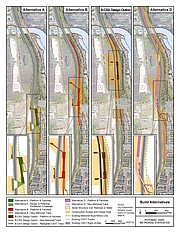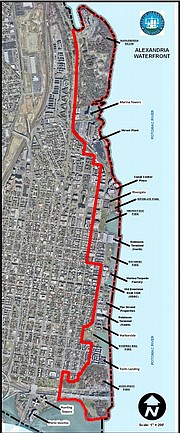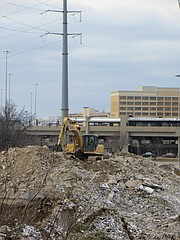Development continues on National Science Foundation and the Park Meridian residential tower. Photo by Vernon Miles.
When asked how Alexandria’s doing, interim City Manager Mark Jinks’ reaction is tepid. The good news is that income is high, as is hotel occupancy, but it basically stops there.
“The region is experiencing a slowdown. [Washington D.C.] was the second fastest growing economy in the country,” said Jinks, but the region has fallen to 14th out of 15 in job growth. “Now Detroit is the only city not growing faster.”
Jinks attributes the slowdown primarily to the stall of federal government spending, the primary economic driver in the region. According to the U.S. Labor Department, the region lost 14,000 total jobs last year, including 10,000 government jobs and gained 6,000 new ones. Even these new jobs, Jinks says, are service industry jobs and are much lower paying than the federal jobs the area was built on. With less people coming to work in Alexandria, apartments in the area have gone down in value.
“Basically, we’re dead in the water,” said Jinks.
The biggest development story for Alexandria in 2015 is the planning for the Potomac Yard Metro Station. According to Jinks, the Metro station is Alexandria’s primary defense against losing more jobs and more office space to development in Tysons and Herndon with the opening of the Silver Line.
“There’s more competition now, with the opening of the Silver Line and more development out east,” said Jinks. “There’s more competition among the localities. In our experience, the metro station at the Potomac Yard development is the best chance at fighting that.”
Jinks warned that Silver Line developments were the biggest immediate threat to Alexandria’s economy. If Alexandria can’t open more development capabilities with metro accessibility, growing companies will look towards the less expensive opportunities.
“There are millions of square feet of unopposed development along the Silver Line,” said Jinks. “Eighty-five percent of office space is built within one-quarter mile of the metro.”
The Potomac Yard Metro is funded primarily from new taxes on developments moving in and the property tax increases on real estate in the immediate vicinity. The city is currently considering five alternative plans for the Metro, including a no build option, which range from a $209 million station built on the tracks at the north end of Potomac Greens to a $492 million station built closer to the Potomac Yard Shopping Center.
“The new Metro station is going to be an incredible asset,” said John Long, president and CEO of the Alexandria Chamber of Commerce, “it’s a major cog in the New Alexandria.”
The Potomac Yard Metrorail Implementation Work Group is scheduled to meet at 7 p.m. on Thursday, Jan. 29 in the City Council Workroom in City Hall.
At a City Council meeting on Jan. 28, city staff laid out the priorities for the long-term Waterfront Development plan. Priorities were identified in a survey of 70 Old Town residents and an assessment from the project’s engineering staff. The top priority, and the first phase of development on the plan, will be the flood mitigation and promenade construction along the waterfront. The flood mitigation and promenade plan is expected to cost $33 million.
“This had better be one glorious promenade,” said Councilwoman Del Pepper.
There has been controversy over the implementation of the City’s Waterfront Development plan, including an impending review by the Virginia Supreme Court of a lawsuit dismissed by the City of Alexandria that alleged that the City had engaged in illegal spot zoning.
Long identified balancing between new construction and maintaining the historic atmosphere as one of the biggest challenges in Alexandria development.
“There’s always a balance,” said Long. “People like change, when it’s something that they like. When change starts, people get excited by that, but it’s really about implementing change well. The hotels have done a really good job of working together with the community. There’s a point where you need to move on, and that’s where Alexandria is right now.”
The first site of private development in the Waterfront plan is already underway at the Indigo Hotel at 220 South Union St. Construction at the site is expected to be completed by Summer of 2016.
At the Jan. 27 City Council meeting, city staff identified the GenOn Power Plant at the northern end of the Waterfront as the largest private parcel of land and as an area of interest for the city to develop. The property has been empty since October 2012.
Alexandria got a big win in 2013 with the announcement that the National Science Foundation would move into the lot adjacent to the Hoffman Town Center on Eisenhower Avenue. The NSF is expected to directly bring in 2,100 new jobs to Alexandria, and Jinks notes that those jobs are part of a high paying and highly educated workforce, but the bigger news for development in the area is the 30,000 visitors to the NSF every year and the expected 60,000 person hotel room occupancy increase.
Between the Patent and Trademark Office (PTO) at one end of Eisenhower Avebue to Telegraph Road just past the metro station, Jinks said the area is going to be full of hotel development for the NSF and PTO. The first stage of the development involved tearing down the empty Trucking Association building on Mill Road adjacent to Route 495. The building, originally constructed in 1984, had been empty since 2007. On a nearby lot on Eisenhower Avenue, construction has begun on the 25-story Park Meridian apartment building, expected to be complete by the end of 2015.
“There are a series of high rise towers planned between there and the metro,” said Jinks. “They’re approved but not financed yet.”
Alexandria’s deal with the NSF came at the cost of a $28 million tax abatement to the foundation, nearly a third of the tax revenue expected. However, Jinks noted that the gain, even with the abatement, is far more than what the city could have expected from anything else that was planned for the lot.
“It’s a $28 million abatement, but we get a $90 million gain,” said Jinks. “That’s over $60 million we wouldn’t have had otherwise … It’s a tax credit for a building that wasn’t here. And we’re getting 60,000 to 90,000 hotel rooms and we’re bringing in the top scientists to the area. We will see consulting firms and businesses come into the area and bring a secondary economic benefit over the long run.”
With regards to future development, Long identified National Harbor as a potential partner in retail growth and trans-Potomac endeavors. Mayor William Euille identified improvements to transportation on the Woodrow Wilson Bridge as a priority for Alexandria. Euille mentioned that there are likely to be transportation, and potentially commercial, effects of the new MGM Casino opening at National Harbor in 2016.
But with development in 2015 centered on Potomac Yard and the Waterfront, some have expressed concerns that western Alexandria is being left behind.
“A lot of focus needs to be on the West End right now,” said Long. “The time has come to recognize that as the next area of major development.”
Most of the development in western Alexandria is focused around housing developments. The Eisenhower West Small Area Plan Committee is expected to present its report to City Council in fall of 2015 detailing land use, connectivity, and density goals for the area. Eisenhower West Small Area Plan’s next community meeting is Monday, Feb. 9 at 7 p.m. at the Beatley Central Library.
The city’s Beauregard Small Area Plan, adopted in 2012, requires $210 million in developer contributions to fund a fire station, affordable housing, landscaping, and increased regional transit. The Beauregard Design Advisory Committee is currently reviewing Developmental Special Use Permit applications for the Beauregard area.
Jinks said that increased transit capabilities are vital to keeping eastern and western Alexandria connected.
“We’re currently working on the Bus Rapid Transit (BRT) to make [the West End] more accessible,” said Jinks. “With Arlington, we’re working on opening the first regional BRT lane that would connect Crystal City and Braddock Road.”
Despite high profile developments in Potomac Yard and around the new NSF building, Jinks said the city can’t afford to lose sight of it’s affordable housing needs.
“The affordable housing on Route 1 is past its life-span,” said Jinks. “It needs redevelopment.”
According to Jinks, the current plan is one-to-one development, which means they redevelop them one building at a time to minimize impact to the community. The public planning for that development is going and will be a part of Jinks’ upcoming discussions with the community.
“We’re trying to do this differently,” said Craig Fifer, director of communications and public information for the City of Alexandria. “We’re hoping for more public input before the city manager proposes his budget. Instead of reacting, we can get that public feedback first.”
At 6:30 in the Lee Center on Feb. 5 and 9, the city will host public meetings to receive public input on the upcoming budget and priorities.




